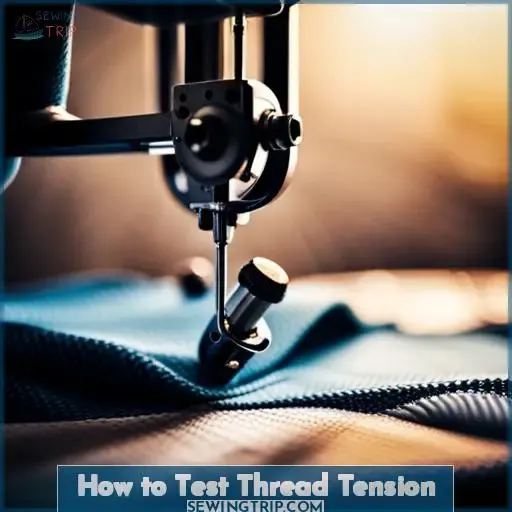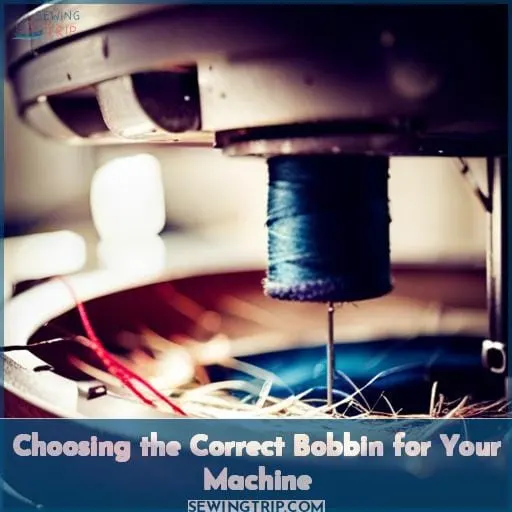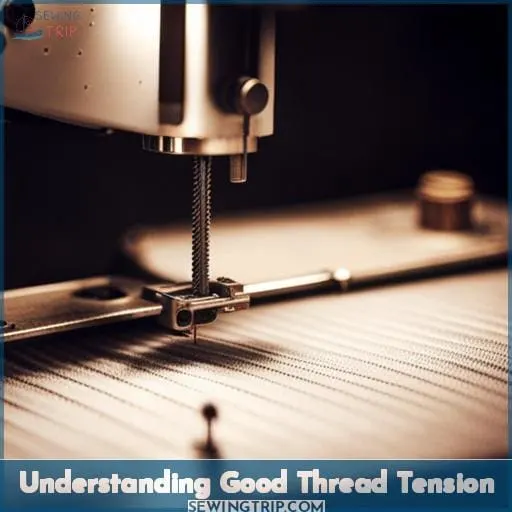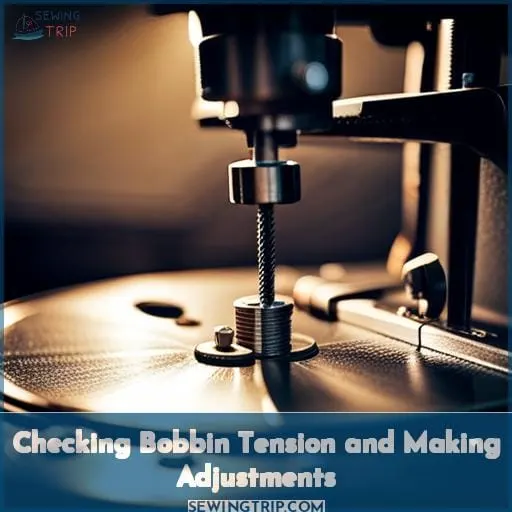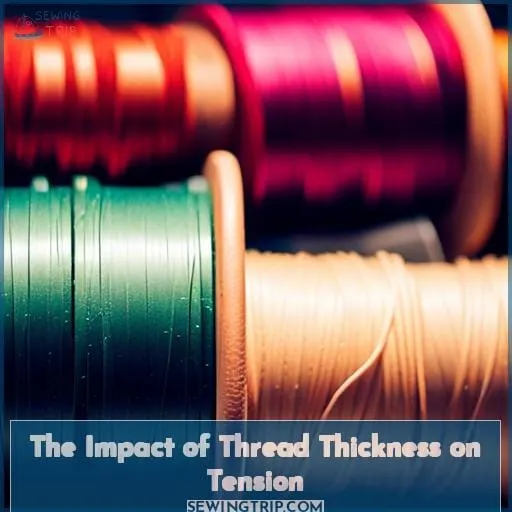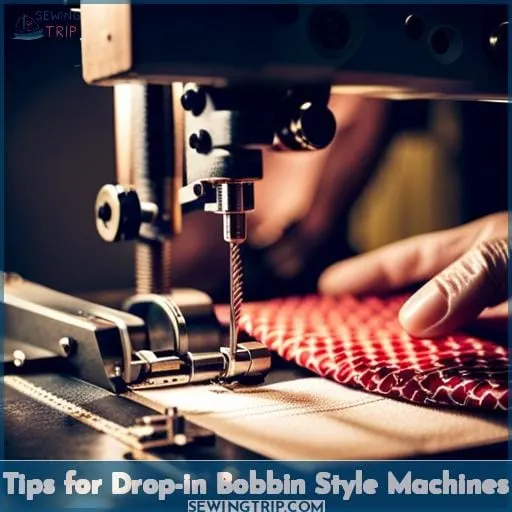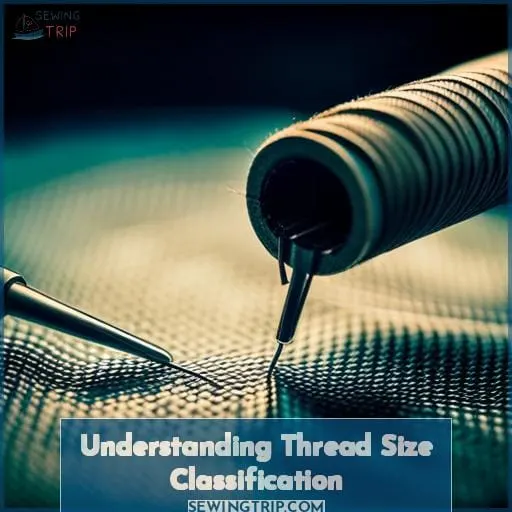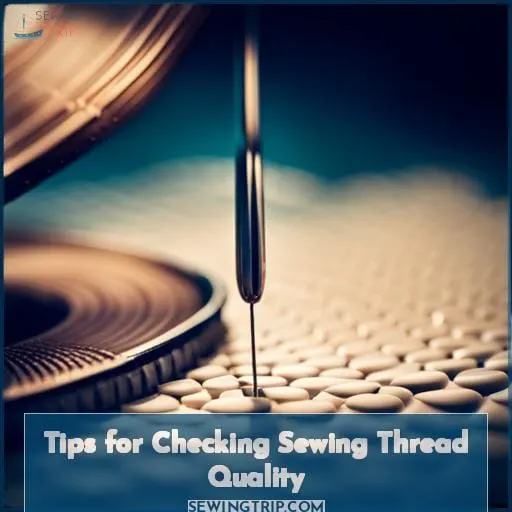This site is supported by our readers. We may earn a commission, at no cost to you, if you purchase through links.
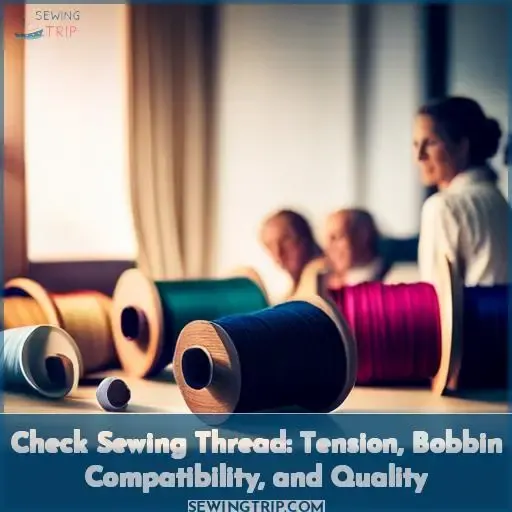 Unravel the mystery of sewing thread with this comprehensive guide on how to check tension, ensure bobbin compatibility, and assess quality.
Unravel the mystery of sewing thread with this comprehensive guide on how to check tension, ensure bobbin compatibility, and assess quality.
Like a skilled detective examining evidence, you’ll learn the importance of proper thread tension and how to test it flawlessly.
Discover the secrets behind choosing the correct bobbin for your machine and avoiding common pitfalls.
With expert tips on understanding good thread tension and checking its quality, you’ll gain power over your sewing projects like never before.
Get ready to master the art of sewing with confidence!
Table Of Contents
- Key Takeaways
- How to Test Thread Tension
- Choosing the Correct Bobbin for Your Machine
- Understanding Good Thread Tension
- Checking Bobbin Tension and Making Adjustments
- The Impact of Thread Thickness on Tension
- Tips for Drop-in Bobbin Style Machines
- Understanding Thread Size Classification
- Tips for Checking Sewing Thread Quality
- Frequently Asked Questions (FAQs)
- Conclusion
Key Takeaways
- Importance of testing bobbin tension
- Tips for checking thread quality
- Impact of thread thickness on tension
- Troubleshooting common tension issues
How to Test Thread Tension
To ensure the quality of your sewing stitches, it’s important to test and adjust the thread tension.
Start by checking the bobbin thread tension, as this plays a crucial role in stitch formation. You can easily test the bobbin tension by pulling on the thread and observing how it moves in relation to the bobbin case.
Importance of Bobbin Thread Tension
Testing the bobbin thread tension is crucial for ensuring proper stitch formation and achieving high-quality sewing results.
To test the bobbin tension,
- Insert a freshly wound bobbin into the bobbin case
- Hold it up by just the thread
- Give a little jerk on the thread to see if the bobbin case slides down slightly, indicating that the tension is perfect.
If it drops freely or doesn’t move at all, adjustments may be needed to make sure it’s not too loose or tight.
Testing Bobbin Tension
To test the tension of your bobbin thread, you can follow these simple steps:
For machines with a removable bobbin case:
- Pull out the bobbin case.
- Drop in a freshly wound bobbin.
- Pinch the thread where it comes out of the case.
- Flick your wrist downward to see if the bobbin falls freely or slides down slightly.
For machines with drop-in bobbins:
- Sew a test seam.
- Adjust the tension by tightening or loosening the screw accordingly.
Adjusting Bobbin Tension
To adjust bobbin tension and test thread tension, you can follow these steps.
First, for machines with a removable bobbin case:
- Pull out the case and drop in a freshly wound bobbin.
- Pinch the thread where it comes out of the case and flick your wrist to see how far the bobbin falls.
- If it drops freely or doesn’t move at all, then you need to adjust the tension using a tiny screwdriver.
For machines with drop-in bobbins:
- Sew a test seam and check if the top thread is too loose or tight on the fabric surface.
- Adjust by tightening or loosening the flat head screw accordingly.
In this section of ‘Check Sewing Thread: Tension, Bobbin Compatibility,
and Quality’, we’ll discuss how to adjust your sewing machine‘s
bobbin tension in order to achieve optimal stitch formation.
Properly adjusting your bobbin tension ensures that stitches meet together
in the middle of fabric without any visible upper threads underneath the project.
By following these simple steps regarding testing thread tension,
you will be able to make necessary adjustments as needed for successful sewing projects.
Choosing the Correct Bobbin for Your Machine
When it comes to choosing the correct bobbin for your machine, there are two options:
- Universal bobbins
- Machine-specific bobbins
Universal bobbins may not fit all machines perfectly and can cause tension issues, while machine-specific bobbins are designed specifically for certain brands or models of sewing machines.
It’s important to check the compatibility list before purchasing a bobbin to ensure proper fit and functioning with your particular machine.
Universal Bobbins Vs. Machine-Specific Bobbins
When choosing the correct bobbin for your machine, it’s important to understand the difference between universal bobbins and machine-specific bobbins.
- Universal bobbins aren’t truly universal and may not be compatible with all machines.
- It’s crucial to check the list of compatible machines before purchasing bobbins.
- Using the wrong bobbin can affect bobbin tension, resulting in issues such as visible thread on top or loose upper thread.
- Ensure proper bobbin compatibility for optimal sewing results.
Bobbin Compatibility With Different Brands
If you own a sewing machine, it’s important to choose the correct bobbin that’s compatible with your specific brand and model.
Different machines require different bobbin sizes, so it’s crucial to ensure you have the right one.
Additionally, consider whether your machine uses plastic or metal bobbins and if there are specific bobbins for vintage machines, sergers, or overlockers.
Choosing the correct bobbin will ensure optimal performance and stitch quality while preventing any potential issues with tension or thread compatibility.
Understanding Good Thread Tension
Understanding good thread tension is crucial for achieving desired stitch formation on your sewing projects.
It involves ensuring that the bobbin thread doesn’t show on the top of your project and that the upper thread doesn’t show on the underside.
By maintaining proper tension, you can avoid uneven stitches, puckering fabric, or breaking threads.
Desired Stitch Formation
Achieving a desired stitch formation is crucial for ensuring the quality and strength of your sewing machine‘s stitches.
- Stitches should meet in the middle of the fabric and lock together evenly.
- Bobbin thread shouldn’t be visible on top or upper thread on the underside.
- Thread thickness affects bobbin tension.
Avoiding Visible Bobbin Thread on Top
To achieve a professional and polished stitch, it’s essential to understand the importance of good thread tension in order to avoid visible bobbin thread on top.
Bobbin thread that shows on the top of your fabric can ruin the appearance of your sewing project.
Proper tension ensures that stitches meet together in the middle of the fabric, locking together evenly without any visibility of bobbin thread.
Adjusting tension according to thread thickness is crucial for achieving optimal results.
Preventing Visible Upper Thread on Underside
To prevent the visible upper thread on the underside of your sewing project, ensure that you have achieved good thread tension.
This involves finding the right balance between lower bobbin tension and upper thread tightness.
- Balance lower bobbin tension
- Avoid bobbin thread that’s too loose or thin
- Prevent upper threading from being overly tight
Checking Bobbin Tension and Making Adjustments
To check the bobbin tension and make necessary adjustments, there are different steps depending on whether your machine has a removable bobbin case or uses drop-in bobbins.
For machines with removable bobbin cases, you’ll need to:
- Remove the case.
- Load in a freshly wound bobbin.
- Perform a flick test to determine if the tension is correct.
On the other hand, for machines with drop-in bobbins, you can:
- Sew a test seam.
- Adjust the tension by tightening or loosening the flat head screw accordingly.
By following these steps carefully and making any needed adjustments, you can ensure that your sewing thread is properly balanced for optimal stitch formation.
Steps for Machines With Removable Bobbin Cases
Checking the bobbin tension and making adjustments is an essential step for those using machines with removable bobbin cases.
To check the tension, pull out the bobbin case from your machine and load in a freshly wound bobbin. Pinch the thread where it comes out of the case and flick your wrist downward to see how far the case moves.
If it falls freely or doesn’t move at all, you may need to adjust its tension using a tiny screwdriver that came with your sewing machine.
Steps for Machines With Drop-in Bobbins
When checking the tension on machines that have drop-in bobbins, you can follow these steps to ensure proper bobbin thread tension:
- Thread the machine and sew a test seam.
- If the bobbin thread is too loose and showing on the top of the fabric, carefully tighten or loosen a flat head screw located near the bobbin case.
- Make small adjustments until you achieve balanced tension between both threads.
Common Issues and Solutions
If you encounter problems with your bobbin tension, there are common issues and solutions that can help you achieve the correct thread tension for optimal stitch formation.
Some common problems include:
- Bobbin thread breaks
- Bobbin thread too loose or too tight
- Visible bobbin thread on top or bottom of your project
Checking the compatibility of your bobbins with your machine and ensuring high-quality threads can also contribute to resolving these issues.
The Impact of Thread Thickness on Tension
When it comes to sewing, the thickness of your thread can have a significant impact on tension.
Thicker threads may not be able to slide freely between the plate and bobbin case, leading to improper stitch formation and potential fabric puckering or breakage.
On the other hand, very fine threads require closer contact between the plate and bobbin case for proper tensioning.
It’s important to consider thread thickness when adjusting tension settings on your machine for optimal stitching results.
How Thread Thickness Affects Tension
To understand the impact of thread thickness on tension, you need to consider how different thread sizes can affect the quality and strength of your stitches.
Thread thickness directly affects bobbin tension, which plays a crucial role in stitch formation.
When using very fine thread, the plate needs to be closer to the bobbin case so that it can properly tension the thin thread.
Conversely, thick threads may not fit between the plate and case properly, resulting in incorrect stitch formation and potential fabric puckering or breakage.
Adjusting Tension for Different Thread Thicknesses
To adjust tension for different thread thicknesses, start by referring to the machine’s manual.
When adjusting tension, consider factors such as thread thickness, bobbin type compatibility, needle size, and fabric weight.
To test tension with different thread colors:
- Thread up using a different color in the top than you’re using in the bottom.
- Check if the top thread is too loose or if it shows underneath.
Adjusting bobbin tension may also be necessary depending on these variables.
Tips for Drop-in Bobbin Style Machines
When using a drop-in bobbin style machine, it’s important to test and adjust the tension for optimal stitch formation.
Good thread tension ensures that stitches meet in the middle of the fabric and don’t show on either side.
By checking your bobbin tension and using the correct bobbins for your machine, you can troubleshoot common tension issues and achieve high-quality sewing results.
Importance of Testing and Adjusting Tension
When using drop-in bobbin style machines, it’s important that you test and adjust the tension to ensure optimal stitch formation.
Proper tension ensures that the top thread and bobbin thread work together effectively.
If the tension is too loose, you may experience loose threads or visible stitches on either side of your fabric.
On the other hand, if the tension is too tight, it can cause puckering or breakage of threads.
Adjusting this balance will result in high-quality stitching and a successful sewing project.
Troubleshooting Common Tension Issues
If you’re experiencing tension issues with your drop-in bobbin style sewing machine, troubleshooting common problems can help you achieve better stitch quality.
If the bobbin thread is too loose or too tight, it can cause issues such as:
- The bobbin thread showing on top
- The upper thread showing on the underside of your project
Adjusting tension and testing it using different colored threads can help identify and fix these problems. Additionally, be mindful that both thread thickness and quality can affect tension.
Understanding Thread Size Classification
Understanding thread size classification is important for proper sewing machine operation.
Different units are used to measure thread size, such as Tex and Denier.
Tex measures the weight in grams of 1,000 meters of thread, while Denier measures the weight in grams of 9,000 meters of thread.
Knowing the weight of your thread will help you choose the appropriate needle and adjust tension settings on your sewing machine for optimal stitch formation.
Different Units Used for Thread Size
Understanding thread size classification involves knowing the different units used to measure thread thickness.
Thread size can be measured in various units such as denier, tex, or weight.
Denier is a unit of measurement commonly used in the textile industry and refers to the mass in grams per 9000 meters of thread.
Tex is another metric unit that measures mass in grams per 1000 meters of thread.
The weight number system assigns a numerical value based on the thickness and strength of the thread.
It’s important to understand these different units when determining which threads are suitable for your sewing projects.
Importance of Knowing Thread Weight
To understand the impact of thread size on tension, it’s important for you to know the weight of your sewing thread.
Understanding thread weight allows you to make informed decisions when selecting a suitable thread for your project.
Here’s why knowing thread weight is crucial:
- Thread weight vs. thickness: Different weights correspond to different thicknesses, which affect how the threads interact with each other and with the fabric.
- Thread weight vs. fabric weight: Matching the right thread weight to your fabric ensures optimal stitch formation and prevents issues like puckering or breaking.
- Thread Weight vs Stitch Length : The choice of stitch length depends on both your desired aesthetic outcome and stability required in seams
- Thread Weight Vs Needle Size : Selecting a needle that corresponds well with can minimize damage done by stitching process
- Thread Weight Vs Bobbin Tension – Correct bobbin tension helps achieve balanced stitches without any visible top or bottom threads showing.
Tips for Checking Sewing Thread Quality
Now it’s time to discuss some tips for checking the quality of your sewing thread. It’s important to be able to identify high-quality thread, as well as test its strength and durability. By following these tips, you can ensure that you’re using the best thread for your sewing projects and achieve optimal results in your stitching.
Tips for Checking the Quality of Sewing Thread:
- Look for a strong, smooth thread. The thread should be strong enough to withstand the stress of being sewn through fabric, but it should also be smooth and not fray easily.
- Test the thread’s strength by pulling on it. A good thread should not break easily when you pull on it.
- Check the thread’s durability by rubbing it between your fingers. A good thread should not fray or pill easily.
- Look for a thread that is the right weight for your project. The weight of the thread refers to how thick it is. The right weight of thread will help you achieve the best results in your stitching.
- Choose a thread that is made from a material that is compatible with your fabric. Some fabrics, such as silk, require a specific type of thread in order to prevent damage.
- Consider the color of the thread when choosing it. The color of the thread should complement the color of the fabric.
Identifying High-Quality Thread
To identify high-quality thread, you can follow these tips for checking the quality of your sewing thread.
First, consider the thread strength and durability. A strong and durable thread will ensure that your stitches hold up well over time.
Next, examine the color consistency of the thread to ensure it’s even throughout.
Additionally, check the size or weight of the thread to match your project’s requirements.
Lastly, consider reputable brands known for their quality threads that offer good value for their price.
Testing Thread Strength and Durability
To ensure the quality of your sewing thread, it’s important to test its strength and durability.
Pulling the thread until it reaches its breaking point will give you an idea of its overall strength.
Additionally, checking for abrasion resistance by rubbing the thread against a rough surface can determine how well it withstands wear and tear.
Testing knot strength by tying knots in the thread and pulling them tight will reveal if the thread holds up under tension.
Lastly, examining UV resistance and thermal resistance properties can help assess how well the thread maintains its integrity when exposed to sunlight or high temperatures respectively.
Frequently Asked Questions (FAQs)
How do I know if my thread tension is too tight?
If your thread tension is too tight, you may notice that:
- The fabric puckers
- The stitches appear strained
- The upper thread may also be pulled to the back of the fabric.
Adjusting bobbin tension can help alleviate this issue.
Can I use any type of bobbin for my sewing machine?
Yes, you can use any type of bobbin for your sewing machine.
However, it’s important to make sure that the bobbin is compatible with your specific machine model to ensure proper stitch formation and tension.
What are the consequences of using thread of the wrong thickness?
Using thread of the wrong thickness can lead to stitching issues.
Thick thread may not fit properly between the bobbin case and plate, causing tension problems and puckering fabric.
It could also break or mess up your stitches.
How do I check the quality of my sewing thread?
To check the quality of your sewing thread, hold one end in each hand and pull until it breaks.
If it breaks easily, toss it out.
If not, keep using it.
Simple as that!
Are there any specific tips for checking sewing thread quality for drop-in bobbin style machines?
For drop-in bobbin style machines, to check sewing thread quality:
- Thread the machine and sew a test seam.
- Check if the bobbin thread is too loose or tight on top of the fabric.
- Adjust the tension screw accordingly for desired results.
Conclusion
To unravel the mystery of sewing thread, it’s crucial to check its tension, ensure bobbin compatibility, and assess its quality.
By understanding the importance of thread tension and how to test it flawlessly, you can gain control over your sewing projects.
Choosing the correct bobbin for your machine and adjusting its tension will prevent common pitfalls.
Additionally, understanding good thread tension and checking its quality will ensure desired stitch formation and durability.
With these expert tips, you can confidently master the art of sewing.

